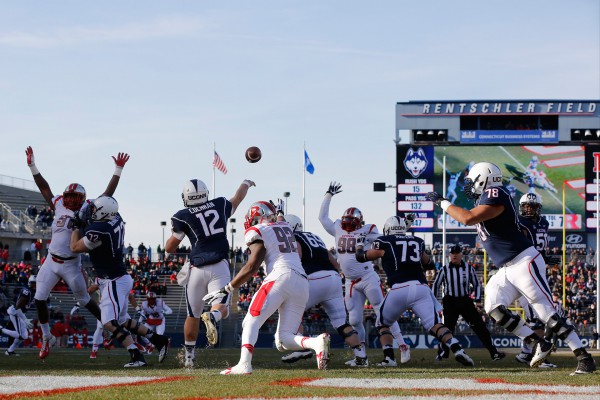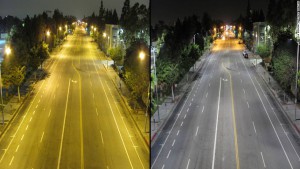LED Street Lights Being Installed in CT Towns Even As Health Concerns Are Raised
/The American Medical Association’s new policy stand “against light pollution and public awareness of the adverse health and environmental effects of pervasive nighttime lighting,” comes as municipalities across Connecticut and the nation are replacing longstanding lighting systems with LED lights in an effort to save money and improve safety. The AMA however, is warning that the rapid pace of change could bring long-term detrimental health and safety effects. The AMA has noted that “it is estimated that white LED lamps have five times greater impact on circadian sleep rhythms than conventional street lamps. Recent large surveys found that brighter residential nighttime lighting is associated with reduced sleep times, dissatisfaction with sleep quality, excessive sleepiness, impaired daytime functioning and obesity.”
The organization noted earlier this month that “approximately 10 percent of existing U.S. street lighting has been converted to solid state LED technology, with efforts underway to accelerate this conversion.” The AMA’s Report of the Council on Science and Public Health on “Human and Environmental Effects of Light Emitting Diode (LED) Community Lighting” cautioned that “white LED street lighting patterns also could contribute to the risk of chronic disease in the populations of cities in which they have been installed. Measurements at street level from white LED street lamps are needed to more accurately assess the potential circadian impact of evening/nighttime exposure to these lights.
The AMA recommendations were developed to “assist in advising communities on selecting among LED lighting options in order to minimize potentially harmful human health and environmental effects”:
- an intensity threshold for optimal LED lighting that minimizes blue-rich light
- all LED lighting should be properly shielded to minimize glare and detrimental human health and environmental effects,
- consideration should be given to utilize the ability of LED lighting to be dimmed for off-peak time periods.
The concerns are not new, but they are receiving greater attention in the wake of the AMA’s formal community guidance and policy position, adopted at the organization’s annual conference in Chicago in mid-June.
Communities in Connecticut that have taken steps to switch to LED lighting include New London, Berlin, Plainville, East Hartford, Rocky Hill, Stamford, Southington, and Cheshire, according to published reports. An article authored by UConn professor of Community Medicine and Health Care Richard G. Stevens, highlights red flags being raised by the AMA regarding the safety of LED lighting being installed in cities around the country. The article first appeared on an international website, theconversation.com, and has since appeared on sites including CNN. Stevens, an expert on the health impact of electric lighting, has raised concerns for more than a decade.
The Illuminating Engineering Society, founded in 1906 and based in New York, noted in a position statement that “exposure to optical radiation affects human physiology and behavior, both directly (acute effects including melatonin suppression, elevated cortisol production, increased core temperature) and indirectly (resetting the internal circadian body clock). There is no confirmation that typical exposures to exterior lighting after sunset lead to cancer or other life‐threatening conditions.” The Illuminating Engineering Society of North America (IES) is described as “the recognized technical authority on illumination.” The IES website indicates that the organization was “not represented in the deliberations leading to [the AMA document]. We intend to contact the AMA and work with them to ensure that any lighting related recommendations include some discussion with the IES.”
ANSES, the French Agency for Food, Environmental and Occupational Health & Safety, has published a report entitled (in English): " Lighting systems using light-emitting diodes: health issues to be considered," which focuses squarely on potential problems caused by LED lighting. The LEDs Magazine website indicates that the full report is available in French only, but the report summary (in English) says that risks have been identified concerning the use of certain LED lamps, raising potential health concerns for the general population and professionals.
"The issues of most concern identified by the Agency concern the eye due to the toxic effect of blue light and the risk of glare," says the report, adding that the blue light necessary to obtain white LEDs causes "toxic stress" to the retina.
Back in 2011, a comprehensive report by Carnegie Mellon University’s Remaking Cities Institute (RCI) on the city of Pittsburgh’s transition to LED street lighting indicated that “Glare is an issue with LED street lighting. The RCI research team’s literature review and interviews with manufacturers and municipal agencies in cities with LED replacement projects indicate that the emphasis is being placed almost entirely on energy savings, to the exclusion of visual quality issues. The substantial glare caused by LEDs is not typically included as a measurable criteria in evaluation processes, and when it is, the tools of measurement are inadequate. As a result, glare persists as an issue.”
That report also noted that “the public is informed that LEDs save energy told that they are better in quality (often false) and that more accurate in color (often false).” In addition, the 113-page report indicated that “While the use of bright lights is believed to reduce accidents, it actually creates dangerous conditions for drivers, especially when night vision is affected by sharp differences in illumination. Bright lights are particularly hazardous for older persons because the human eye’s accommodation reflex slows with age.”
Regarding health concerns that have been raised, the report indicates that “Bright white light suppresses melatonin, the hormone that regulates tumors. Blue light wavelengths are to blame, because they ‘reset’ the circadian clocks of humans, animals, and plants even at very low levels of blue light. This might account for the significantly higher rates (30-60%) of breast and colorectal cancer in night shift workers.”
Some have compared the growing controversy regarding LED lighting to the ongoing debate in towns around the country regarding the use of crumb rubber from recycled tires as fill for sports turf fields. Federal, state, and municipal governments have weighed in on the discussion, but even as health concerns continue to be raised, fields using the materials continue to be installed and used by youth in Connecticut and across the country. The U.S. Environmental Protection Agency recently launched a research project aimed at providing better answers on that safety question.




 The site said of
The site said of  s, including:
s, including: Funding for the competition prize awards will be provided both by the State of Connecticut, which has committed $1 million, and an additional $2 million commitment from private partners. The Doris Duke Charitable Foundation, The Kresge Foundation, Living Cities, NeighborWorks America, The United Illuminating Company, Stanley Black & Decker, Boehringer Ingelheim, Travelers Companies, Inc., The Hartford Foundation for Public Giving, Webster Bank, Eversource Energy, Liberty Bank Foundation, Hartford HealthCare, Barnes Group, Hoffman BMW of Watertown/Hoffman Auto Group, United Technologies Corp., Charter Communications, and Fairfield County’s Community Foundation have all committed to participating in the challenge.
Funding for the competition prize awards will be provided both by the State of Connecticut, which has committed $1 million, and an additional $2 million commitment from private partners. The Doris Duke Charitable Foundation, The Kresge Foundation, Living Cities, NeighborWorks America, The United Illuminating Company, Stanley Black & Decker, Boehringer Ingelheim, Travelers Companies, Inc., The Hartford Foundation for Public Giving, Webster Bank, Eversource Energy, Liberty Bank Foundation, Hartford HealthCare, Barnes Group, Hoffman BMW of Watertown/Hoffman Auto Group, United Technologies Corp., Charter Communications, and Fairfield County’s Community Foundation have all committed to participating in the challenge. “We are pleased to bring the Working Cities Challenge to Connecticut and are thankful to Governor Malloy for his support of the effort, as well as the Hartford Foundation, the Doris Duke Foundation, Living Cities, The Kresge Foundation, and many others,” Boston Fed President Eric Rosengren said. “The partners have come together to make it possible to bring the competition to Connecticut – precisely the model of cross-sector collaboration that forms the basis of the Working Cities Challenge. This competition focuses on the residents of the state’s postindustrial cities – places with unique assets that taken together can help to build civic leadership infrastructure, which our research shows is a key component of economic resurgence.”
“We are pleased to bring the Working Cities Challenge to Connecticut and are thankful to Governor Malloy for his support of the effort, as well as the Hartford Foundation, the Doris Duke Foundation, Living Cities, The Kresge Foundation, and many others,” Boston Fed President Eric Rosengren said. “The partners have come together to make it possible to bring the competition to Connecticut – precisely the model of cross-sector collaboration that forms the basis of the Working Cities Challenge. This competition focuses on the residents of the state’s postindustrial cities – places with unique assets that taken together can help to build civic leadership infrastructure, which our research shows is a key component of economic resurgence.” “It’s gratifying to see the strong support from Connecticut companies, foundations, and the Malloy administration for the Working Cities Challenge under the thoughtful leadership of the Boston Fed,” James C. Smith, Chairman and CEO of Webster Bank, said. “By encouraging the development of civic infrastructure as a prerequisite to physical infrastructure, the Working Cities Challenge promises to revitalize Connecticut’s smaller cities economically and transform the lives of inner city residents.”
“It’s gratifying to see the strong support from Connecticut companies, foundations, and the Malloy administration for the Working Cities Challenge under the thoughtful leadership of the Boston Fed,” James C. Smith, Chairman and CEO of Webster Bank, said. “By encouraging the development of civic infrastructure as a prerequisite to physical infrastructure, the Working Cities Challenge promises to revitalize Connecticut’s smaller cities economically and transform the lives of inner city residents.”
 A recent report in Business Insider indicated that one in three new businesses in the U.S. were started by an entrepreneur age 50 or older. Describing “running a business as the new retirement,” the news report cited an infographic in easylifecover that highlighted those aged 55-64 in the U.S. have actually had the highest rate of entrepreneurial activity in the last 10 years, noting that the founders of McDonald's, Coca Cola, and Kentucky Fried Chicken – among others - were all over 50 when they established their businesses.
A recent report in Business Insider indicated that one in three new businesses in the U.S. were started by an entrepreneur age 50 or older. Describing “running a business as the new retirement,” the news report cited an infographic in easylifecover that highlighted those aged 55-64 in the U.S. have actually had the highest rate of entrepreneurial activity in the last 10 years, noting that the founders of McDonald's, Coca Cola, and Kentucky Fried Chicken – among others - were all over 50 when they established their businesses. The interactive “Boot Camp” event at reSET – open to people of all ages with a special focus on the 50 and over –included short presentations from local resource organizations, networking opportunities and valuable information on the programs and tools available to potential business owners. Attendees were updated on the necessary steps and tools to launch a business, and had opportunities to talk one-on-one with local mentoring organizations, lenders, small business advisors and community leaders for advice and assistance.
The interactive “Boot Camp” event at reSET – open to people of all ages with a special focus on the 50 and over –included short presentations from local resource organizations, networking opportunities and valuable information on the programs and tools available to potential business owners. Attendees were updated on the necessary steps and tools to launch a business, and had opportunities to talk one-on-one with local mentoring organizations, lenders, small business advisors and community leaders for advice and assistance. hand at the reSET event in mid-June were representatives of the Office of Secretary of State (where new businesses are registered),
hand at the reSET event in mid-June were representatives of the Office of Secretary of State (where new businesses are registered),  reSET serves all entrepreneurs, but specializes in social enterprise ― impact driven business with a double and sometimes triple bottom line. In addition to providing co-working space and accelerator and mentoring programs, reSET aims to inspire innovation and community collaboration, and to support entrepreneurs in creating market-based solutions to community challenges. The organization’s goal is to “meet entrepreneurs wherever they are in their trajectory and to help them take their businesses to the next level.”
reSET serves all entrepreneurs, but specializes in social enterprise ― impact driven business with a double and sometimes triple bottom line. In addition to providing co-working space and accelerator and mentoring programs, reSET aims to inspire innovation and community collaboration, and to support entrepreneurs in creating market-based solutions to community challenges. The organization’s goal is to “meet entrepreneurs wherever they are in their trajectory and to help them take their businesses to the next level.”



 In recent years, the Connecticut program, coordinated by Connecticut’s Old State House with support from Connecticut Humanities, has grow in numbers and in the quality of the students’ work, organizers point out. This year, Connecticut History Day had 10,600 points of contact with Connecticut students, teachers, parents and history professionals, including workshops for 4,500 students—twice last year’s number.
In recent years, the Connecticut program, coordinated by Connecticut’s Old State House with support from Connecticut Humanities, has grow in numbers and in the quality of the students’ work, organizers point out. This year, Connecticut History Day had 10,600 points of contact with Connecticut students, teachers, parents and history professionals, including workshops for 4,500 students—twice last year’s number.

 In addition to its impact on drivers, the AMA notes that blue-rich LED streetlights operate at a wavelength that most adversely suppresses melatonin during night. It is estimated that white LED lamps have five times greater impact on circadian sleep rhythms than conventional street lamps, the AMA indicated. Recent large surveys, according to the AMA, found that brighter residential nighttime lighting is associated with reduced sleep times, dissatisfaction with sleep quality, excessive sleepiness, impaired daytime functioning and obesity.
In addition to its impact on drivers, the AMA notes that blue-rich LED streetlights operate at a wavelength that most adversely suppresses melatonin during night. It is estimated that white LED lamps have five times greater impact on circadian sleep rhythms than conventional street lamps, the AMA indicated. Recent large surveys, according to the AMA, found that brighter residential nighttime lighting is associated with reduced sleep times, dissatisfaction with sleep quality, excessive sleepiness, impaired daytime functioning and obesity.
 The Conversation website is a collaboration between editors and academics to provide "informed news analysis and commentary that’s free to read and republish." It
The Conversation website is a collaboration between editors and academics to provide "informed news analysis and commentary that’s free to read and republish." It  PHOTO: Traditional street lighting (left) vs. LED lighting (right).
PHOTO: Traditional street lighting (left) vs. LED lighting (right).

 Lewis’ commitment and dedication impressed the judging panel.
Lewis’ commitment and dedication impressed the judging panel.

 “Wholesome Wave is thrilled by the innovations that USDA is supporting through the new FINI grants, which are taking the work of increasing affordable access to healthy food to even greater levels of impact,” said Michel Nischan, CEO & Founder of Wholesome Wave. “So many SNAP shoppers are working parents with limited time to source healthier food choices. Through the new Farm-to-Grocery model, our partners in Connecticut and Vermont will be able to expand affordable access to SNAP consumers in a way that allows them to find and purchase more healthy food from a variety of retailers.”
“Wholesome Wave is thrilled by the innovations that USDA is supporting through the new FINI grants, which are taking the work of increasing affordable access to healthy food to even greater levels of impact,” said Michel Nischan, CEO & Founder of Wholesome Wave. “So many SNAP shoppers are working parents with limited time to source healthier food choices. Through the new Farm-to-Grocery model, our partners in Connecticut and Vermont will be able to expand affordable access to SNAP consumers in a way that allows them to find and purchase more healthy food from a variety of retailers.”




























